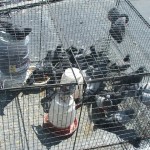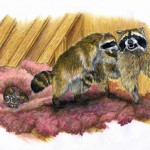 Here at Allstate Animal Control, we’re well aware of how clever and interesting pigeons are, but we also know of the various dangers of pigeons. Pigeons bring in disease-carrying bugs, create messy nests and roosts in the eaves and roofs of buildings, destroy attic insulation, attract mice, rats and bugs, leave pigeon droppings all over the sides of buildings and anything below. The high content of uric acid in their droppings is so caustic that it weakens wooden joists, concrete and other building material. Pigeons have been to blame for bridges weakening to the point of collapse. Paul Gascoigne, known as Gazza, described another danger of pigeons. The former England international footballer and football manager, dubbed as the “most naturally gifted English midfielder of his generation”, once begged out of training because of an incident with a pigeon. He’d arrived at the stadium early and offered to help a ground staff employee get rid of a pigeon off the White Hart Lane roof. He climbed up onto the roof and successfully chased the pigeon away, but then fell 30 feet from the roof. He was lucky, ending up with no broken bones, but a wicked large bruise down the side of his body. Animal trappers are definitely used to the risks of getting rid of animals from unusual or high places. Gazza was lucky, but it’s a good thing he wasn’t facing an angry raccoon mama on top of that roof. Pigeons are dangerous enough, apparently.
Here at Allstate Animal Control, we’re well aware of how clever and interesting pigeons are, but we also know of the various dangers of pigeons. Pigeons bring in disease-carrying bugs, create messy nests and roosts in the eaves and roofs of buildings, destroy attic insulation, attract mice, rats and bugs, leave pigeon droppings all over the sides of buildings and anything below. The high content of uric acid in their droppings is so caustic that it weakens wooden joists, concrete and other building material. Pigeons have been to blame for bridges weakening to the point of collapse. Paul Gascoigne, known as Gazza, described another danger of pigeons. The former England international footballer and football manager, dubbed as the “most naturally gifted English midfielder of his generation”, once begged out of training because of an incident with a pigeon. He’d arrived at the stadium early and offered to help a ground staff employee get rid of a pigeon off the White Hart Lane roof. He climbed up onto the roof and successfully chased the pigeon away, but then fell 30 feet from the roof. He was lucky, ending up with no broken bones, but a wicked large bruise down the side of his body. Animal trappers are definitely used to the risks of getting rid of animals from unusual or high places. Gazza was lucky, but it’s a good thing he wasn’t facing an angry raccoon mama on top of that roof. Pigeons are dangerous enough, apparently.
Monthly Archives: February 2015
Utah’s Mild Winter and Wild Animals
 The entire country has seen weird weather patterns so far in 2015. Unusually mild and warm in some places, freezing temperatures and dramatic amounts of snow in other areas. Mother nature is tricking wildlife, and we should be prepared for the impact.
The entire country has seen weird weather patterns so far in 2015. Unusually mild and warm in some places, freezing temperatures and dramatic amounts of snow in other areas. Mother nature is tricking wildlife, and we should be prepared for the impact.
In Utah, the weather has been so relatively warm and mild that daffodils and tulips have already started to bloom in early February. Bears are already waking up from hibernation. We’re not seeing as many bald eagles in Utah, likely because they didn’t need to migrate as far south this year.
Utah’s wild animals are much more active this time of year because of the mild winter and early food sources. A bumper crop of nuts or berries and other food sources also means a “bumper crop” of wild animals in Utah, like mice, rats, squirrels, pigeons, sparrows, opossums and other birds. More of the smaller wild animals will attract more predatory animals, like raccoons, skunks, coyotes and snakes.
Let’s not forget the impact of a low snow-pack level. Not only has Utah been relatively warm, but it’s also been relatively dry. Lower snow fall means Utah may face drought conditions this year. In a drought, the natural food and water sources dry up, and shelter becomes more scarce. We may see more wild animal-human conflicts in Utah as wild animals migrate into residential areas in search of easier food and water and shelter.
Whether Utahans are cheering or lamenting the unusual weather, the smart move is to prepare for unusual wild animal activity. Allstate Animal Control can set up an inspection for homes, offices, warehouses, church buildings, schools, stables or other outbuildings. An inspection will reveal if you already have a problem with a wild animal, if there are things around or on your property that will attract a wild animal, and what prevention methods are best for you. If you already have a problem, Allstate Animal Control sends out technicians who remove dead animals, repairs animal damage, sanitizes the area in which wild animals have lived, trap animals, gets rid of wild animals, and installs exclusion materials to prevent wild animals from returning to your building. Contact Allstate Animal Control today at 1-888-488-7720, or at allstateanimalcontrol.com.
Skunk in the Window Well
Redoing your lawn is hard enough without having to deal with a skunk in the window well, what started out as normal Saturday morning, with raking leaves pulling weeds and tearing out old grass, turned into a smelly, week-long disaster. About a month ago my wife complained that the grass was dead, plants were rotting, fence was outdated, and the deck and lawn decorations were sundried and cracking; it was time for a full lawn makeover, or so she said. I didn’t think it was such a good idea until my oldest daughter, Charity, wanted to go out with a boy on that same day, then it was in full swing, an all hands on deck situation. Everyone had a job and there would be NO fourteen year olds going on a date. I know my wife would have shut my plan down if she didn’t want a new lawn as badly as she did.
My oldest son Mikey and I set to work on ripping out the old chain-link fence while my wife and youngest son Andrew started ripping out the plants (it was more my wife, Drew is only four but he did his best to help), Charity and her sister were assigned to chip off the old stain, and repaint the deck. When she wasn’t mumbling about how stupid and unfair it was, I think Charity secretly had a good time; until she found the skunk. She was getting a drink from the hose on the side of the house, to do this she had to bend over right near the window well, right where he was trapped, and afraid. We didn’t know what had happened when we heard her scream but it didn’t take us very long to smell it.
Now, we had two problems; one: my daughter was LIVID and smelled like skunk butt, and two: we had a skunk in the window well that we couldn’t get out. It was obvious that picking it up and carrying it out wasn’t plausible, unless Charity did it since she had already been sprayed, but there was no way on Earth she was going near anything but a bath in tomato soup, so instead we tried to build it a ramp. We put on our hazmat suits (doctor masks, goggles, leather gloves, and head to toe clothing) and carefully slid a plank down into the window well. Knowing fully well skunks aren’t exactly renowned climbers, we attached small pegs it could use to climb up and out with.
Unfortunately, this plan failed and none of us were brave enough to try and put a trap down with it, and remove it if he was caught. After a week of no luck with the creature, we decided there was only one thing we could do, I got my .22 and handled the situation. Our house, and daughter, stunk for quite a while, Charity hasn’t forgiven me yet for the incident, but we’ll never forget the family bonding we had when we found the skunk in the window well.
Winter Storms and Wild Animal Problems
The winter storms that have pummeled the East coast have certainly disrupted life for all of us, from thousands of canceled flights, to having to shovel the driveway several times a day, to braving icy and snowy roads to get to work or school. But, the harsh winter conditions have challenged some wildlife populations and made life easier for other wild animals. Long periods of deep snow mean death to the weak and sick among raccoons, skunks, opossums, deer, rabbits and birds, especially the weaker or sick animals. Food is more difficult to find, which provokes wild animals like raccoons, skunks, opossums, foxes and coyotes to wander through residential and commercial areas in search of easier food and water sources. People are more likely to have run-ins with wild animals who seek out the warmth of spaces under homes and other buildings. Raccoons, squirrels, pigeons and rodents get into warm attics or walls and hunker down from the cold. Ground-dwelling animals, like voles, gophers, groundhogs or moles, enjoy deep snow since it insulates their burrows and protects them from being spotted by predatory animals like coyotes, skunks, raccoons or owls. Deep snow right now might result in higher rodent populations, more vole problems in the spring, which will in turn attract their predators once the snows have melted. So, between shoveling the driveway and de-icing your car, you might want to be proactive in taking care of the wild animal problem you might not even know you have until they start to damage your home, car or yard. Contact Allstate Animal Control at 1-888-488-7720 or visit our home page at allstateanimalcontrol.com to schedule an appointment with a wild animal specialist. Wildlife Trappers will visit your home or business; inspect your building for signs of wild animals, wild animal damage, or weaknesses in the structure that allow animals to enter your building. They will remove wild animals and install materials to prevent them from getting into your walls, attic or crawlspace. They can even remove the dead animals that have died under your home or outbuilding, or in the attic, or walls, chimney, basement or crawlspace. They will clean and sanitize the area and make it safe for your family. Violent winter storms are difficult enough to endure, you don’t want to deal with a wild animal problem on top of everything else.